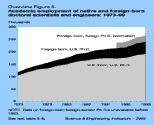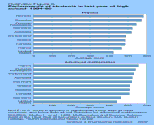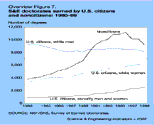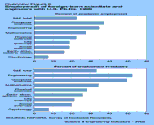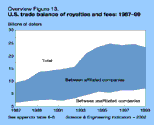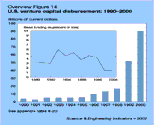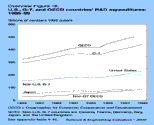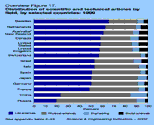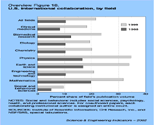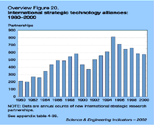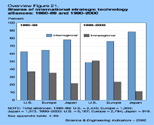The United States in a Changing World 
As the 21st century begins, the United States occupies a position of strength in the support and conduct of research and development (R&D). U.S. R&D expenditures equal the combined total expenditures of Japan, the United Kingdom, Canada, France, Germany, and Italy. U.S. scientists and engineers produce nearly one-third of the articles published in the world's most influential technical journals. U.S. researchers participate in a wide range of international collaborative research efforts, and the results of these efforts are widely cited by scientists in other countries, attesting to their quality and usefulness.
The United States has managed to turn its R&D strengths to its economic and commercial benefit. Industry's recognition of the importance of research and development to profit growth is reflected in the strong expansion of its own R&D spending. Firms have also invested heavily in information and communication technology that enables them to accelerate product development cycles. Industry has formed joint ventures with other companies, universities, and international partners. Moreover, industry spinoffs and underwriting of new ventures have become more common. A large and flexible venture capital industry has provided both capital and managerial assistance for many new enterprises.
The Federal government has fostered a broad base of research activity, especially in academia, where Federal funds represent about 60 percent of total R&D spending. The nation's universities and colleges train new generations of researchers and also perform nearly half of the nation's basic research, which underlies the many technological innovations. Although overall inflation-adjusted Federal R&D funding declined by about 9 percent during the 1990s, it increased by 42 percent for academic R&D—a rise driven largely by increases in the life sciences. (See figures O-1  and O-2 and O-2  .) During the same period, however, funding for the physical sciences and engineering slowed, a development which has sparked critical commentary by many in the scientific and science policy communities. .) During the same period, however, funding for the physical sciences and engineering slowed, a development which has sparked critical commentary by many in the scientific and science policy communities.
To foster the transfer of knowledge from academia to industry, the U.S. government has encouraged universities to patent their inventions and to collaborate with industry. University patenting has grown rapidly, particularly in the life sciences, and during much of the past decade academic research articles were increasingly cited on U.S. patents. (See figure O-3  .) Industry-university collaboration has taken many forms, from traditional faculty consulting to special R&D contracts, licensing arrangements, R&D joint ventures, and spinoff firms established by academic institutions. .) Industry-university collaboration has taken many forms, from traditional faculty consulting to special R&D contracts, licensing arrangements, R&D joint ventures, and spinoff firms established by academic institutions.
Governments and firms around the world have taken note of these perceived U.S. strengths. Governments have initiated broad national and regional efforts to capture similar benefits. In addition to emphasizing market forces and liberalization of investment and labor market rules, their strategies have included strong investments in education and training. In the latter part of the 1990s, these developments have reflected a growing conviction that some kind of new economic reality was coming into existence—a "knowledge-based" economy, marked by the systematic generation, distribution, and use of research knowledge for economic gain. This notion, emanating from the United States, seemed to be underscored by the positive U.S. economic performance in the latter half of the 1990s.
Government and industry efforts in other nations may foreshadow the eventual creation of new centers of scientific, technological, and engineering excellence. The resulting international knowledge flows may benefit all nations but will also pose challenges to those seeking to exploit these flows effectively. Trends that afford a glimpse of key future aspects of the world context for the U.S. science and technology (S&T) enterprise are examined within this framework.
Education, Demographics, and World Labor Markets 
The sine qua non of a modern economy is a well-educated, versatile workforce able to conduct R&D and to convert its results into innovative products, processes, and services. In many nations, government investment in education has resulted in broadening the base of their populations with education beyond the high school level. As a result, rates of postsecondary degree conferral in these nations began increasing in the 1970s and accelerated further in the 1990s in the scientific and technical fields.
Within science and engineering (S&E), the fields of natural sciences and engineering (NS&E) command special attention because of their importance to the conduct of much of the nation's R&D and to the development of industrial innovation. Other countries are building up the NS&E capabilities of their younger cohorts at a greater rate than the United States has been able to achieve. They have been able to raise—by large increments—the rate at which their college-age youth earn first university NS&E degrees. By contrast, in the United States, this rate has fluctuated between 4 and 5 percent of the Nation's 24-year olds for the past four decades and barely reached 6 percent in the late 1990s. (See figure O-4  .) .)
Combining these trends—an emphasis on international mobility of highly educated personnel, continued support for broader access to higher education, and an emphasis on NS&E training—with a shift to more market-driven economies, liberalized investment and labor markets, may lead to the development of new world-class centers of excellence around the globe. In pursuit of this goal, governments are adopting specific policies to imitate and improve on aspects of others' S&T systems and practices.
Although these developments appear to pose little short-term challenge for the United States, they may be important in the long term:
- The United States may face increased international competition for highly educated personnel. Furthermore, its relative attractiveness may erode as living standards rise in developing countries and as other industrialized nations intensify their international recruitment efforts.
- U.S. preeminence in S&T may erode as competing centers of excellence are established elsewhere. Foreign graduates may find returning home more attractive than staying in the United States after their training, and industry may locate increasingly sophisticated functions overseas.
Both developments have technology transfer implications for the United States.
U.S. Reliance on Foreign-Born Scientists and Engineers 
The United States has long relied heavily on scientists and engineers who were born abroad, and increasingly so in the closing years of the 20th century. Many of them earned their highest degrees in the U.S., others entered the country with degrees earned abroad. This reliance rises the more advanced the degree. In the United States in 1999, 10 percent of those holding baccalaureate degrees in S&E were born abroad. This figure was 20 percent for master's degree recipients and 25 percent or greater for doctorate-holders (much higher in some engineering and computer science fields). These estimates are conservative in that they fail to reflect the strong upswing in immigration during the 1990s, those who entered the United States on temporary visas during the 1990s, and those in health-related fields. (See figure O-5  for academic employment.) for academic employment.)
If other countries and regions build up their indigenous S&T capabilities, they may diminish the relative attractiveness of the United States as a destination country. Although such a decline would be difficult to quantify, anecdotes suggest that experienced scientists and engineers, particularly those originally from Asia, are even now returning to their native countries. They may be drawn not only by the potential to gain wealth and prestige but also by the desire to contribute to the economic development of their home countries. On the other hand, more than half of the younger foreign students who have earned S&E doctorates in the United States stay in the U.S., and this trend has changed little over time.
As more countries seek to develop a knowledge-based economy, demographic factors will come into play. For many advanced industrial nations, this means aging—and, in the case of Japan and Germany, declining—populations and shrinking pools of young people. In fact, a broad international dialog has begun to focus on the reality of and potential for broader international mobility of scientists, engineers, and other highly trained technical workers. If other countries begin looking abroad to supplement their labor pools, particularly in high-technology areas, the United States may have more difficulty attracting and retaining foreign scientists and engineers.
Actions by countries that have supplied personnel ("donor" countries) form the other part of this development. If they can build indigenous S&T infrastructures and economies to exploit the fruits of S&T, domestic labor market needs may entice more of their scientists and engineers to stay at home rather than to seek work abroad. They may also attract investments from foreign firms seeking access to their labor and markets. Thus, traditional donor countries may be able to moderate the outflow of their scientists and engineers.
The large unknown factor is the action of multinational firms as they expand their role in international business activities. Many of these firms maintain R&D, technical, and design centers worldwide, drawing on local strengths but also allowing highly trained personnel to rotate to other parts of the world. These activities mean that technological know-how is being transferred around the globe and will become part of other nations' economic development strategies. The inevitable transfer of technological know-how and the possible relocation of high-end activities from the United States (and other mature industrial nations) to newer centers of excellence bear watching.
Growing global competition for experts may be the eventual result of improved living standards in countries around the world; the rise of competing international centers of scientific, technical, and engineering excellence; and the need of many industrialized nations to augment their own technical labor pools from abroad. Increasingly, industry may need to locate near a generous supply of highly trained, reasonably priced personnel. Information technology (IT) developments may further enhance the ability to tie together globally distributed laboratories and firms.
In this situation, one challenge for the United States would seem to be to provide a well-trained domestic S&T workforce. Gordon Moore, cofounder of Fairchild Semiconductor and the Intel Corporation, commented in the New York Times (2001): "[W]e're in danger of exporting a lot of technological advantage because we're not training enough people here. Education, that's our Achilles' heel." Several factors affect a possible expansion in the number of S&E degrees earned by U.S. citizens.
U.S. Elementary and Secondary Education: International Perspective 
How can the United States produce more high-quality homegrown scientists and engineers? The question leads one to focus on the U.S. elementary and secondary education system. Long-standing concerns about the overall quality of the system, and of mathematics and science education in particular, have prompted various reform efforts predating the 1983 report, A Nation At Risk. In international comparisons, these reforms have yet to fully demonstrate their intended results.
U.S. students in the early grades tend to do well in cross-national comparisons of mathematics and science achievement. However, toward the end of high school, U.S. students tend to fall below international averages and to rank substantially below students in a number of other countries. (See figure O-6  .) In some advanced subjects, such as advanced calculus, performance by the top 5 percent of U.S. students is matched by the top 10–20 percent of students in several other countries. .) In some advanced subjects, such as advanced calculus, performance by the top 5 percent of U.S. students is matched by the top 10–20 percent of students in several other countries.
Universal education in the United States does not appear to account for the discrepancy in international test performance. Many countries have raised their age cohort rates of producing natural scientists and engineers to levels exceeding those of the United States. A prerequisite for this development is quality mathematics and science education in the primary and secondary grades, which is being provided by many countries, according to international test results.
In the United States, the transition from high school to college presents another puzzle. State mandates emphasizing academics have expanded, and more mathematics and science courses are required for graduation. Yet, as more students have taken these courses, including advanced ones, the need for remedial instruction at the college level has continued to expand. A number of universities have begun to limit credits given for advanced-placement courses, considering some of them to fail to meet college-level standards.
U.S. Higher Education 
The U.S. higher education system has continually produced a growing number of people with bachelor's, master's, and doctoral degrees. In the past quarter century, the number of bachelor's degrees conferred in all fields has risen from 955,000 to nearly 1.2 million annually; master's degrees, from 278,000 to 420,000; and doctorates, from 33,800 to 45,700. In the 1990s, about 35 percent of the bachelor's degrees, 30 percent of the master's degrees, and more than 60 percent of the doctorates were awarded in S&E fields.
The number of doctorates awarded in S&E rose rapidly after the mid-1980s, but little growth was seen in the number of doctorates awarded to U.S. citizens. The increase from 20,000 in 1986 to almost 29,000 in 1998 (followed by a dip to 27,000 in 1999) mostly reflected the growing number of degrees awarded to foreign-born individuals. This trend was especially pronounced in the natural sciences and engineering, where the share of doctorates earned by U.S. citizens (including naturalized citizens) dropped from 70 to 56 percent over the past 25 years. For all of S&E, including the social sciences and psychology, the U.S. share fell from 74 to 61 percent.
Virtually all growth of doctorates earned by U.S. citizens reflected degrees earned by white women and minority students of both sexes. (See figure O-7  .) A particularly compelling example is offered by the increase in S&E doctorate-holders who were U.S. citizens, from 14,200 in the mid-1970s to 16,700 in 1999. The entire increase is attributable to the rise in the number of women and minorities earning S&E doctorates; the number of U.S. men obtaining these degrees actually declined from about 12,000 in the mid-1970s to 9,700 late in the century. In 1999, women earned 42 percent of these U.S. citizen S&E doctorates, up from 18 percent 25 years earlier; minorities earned 15 percent, up from less than 5 percent. The percentages for U.S. citizen doctorates in the narrower category of natural sciences and engineering (i.e., without social sciences and psychology) show similar trends. .) A particularly compelling example is offered by the increase in S&E doctorate-holders who were U.S. citizens, from 14,200 in the mid-1970s to 16,700 in 1999. The entire increase is attributable to the rise in the number of women and minorities earning S&E doctorates; the number of U.S. men obtaining these degrees actually declined from about 12,000 in the mid-1970s to 9,700 late in the century. In 1999, women earned 42 percent of these U.S. citizen S&E doctorates, up from 18 percent 25 years earlier; minorities earned 15 percent, up from less than 5 percent. The percentages for U.S. citizen doctorates in the narrower category of natural sciences and engineering (i.e., without social sciences and psychology) show similar trends.
In short, at the highest level of S&E training, the United States has relied heavily on noncitizens, U.S. women, and small but growing numbers of minority students of both sexes to sustain its degree production without whose increasing participation the number of S&E doctorates would have stagnated or declined. The reasons for the relative disappearance of U.S. majority males from these fields, including lack of interest and the attractiveness and availability of alternatives, remain largely unexplored.
Status of U.S. S&E Workforce 
In the late 1990s, the active U.S. S&E workforce numbered about 11 million out of a civilian labor force of about 140 million. It included 10.5 million people with a bachelor's or higher degree in S&E and 600,000 people with degrees in other fields but working in an S&E occupation, narrowly defined. The relatively small size of the S&E workforce so defined, about 8 percent of the total, belies its importance to a knowledge-based economy. Scientists and engineers are essential to the conduct of R&D, and they contribute heavily to technological innovation and the economic growth it generates.
Industry, the largest job source for scientists and engineers, employs 75 percent of those with S&E bachelor's degrees, more than 60 percent of master's degree holders, but less than one-third of those with doctorates. Overall, the academic sector has been the second largest employer of scientists and engineers but the largest employer of S&E doctorate-holders. The Federal Government attracted only 4–5 percent of bachelor's and master's degree recipients, with engineering graduates more likely than science graduates to find Federal employment.
In 1999, only about 3.3 million of the 11 million S&E labor force worked in the core S&E occupations defined here, less than 3 percent of total civilian employment. Almost three-quarters of those 3.3 million had jobs as engineers (39 percent) and computer scientists and mathematicians (33 percent). Although most S&E degree-holders work in non-S&E occupations, the interpretation that these highly trained individuals are not using their special skills is incorrect.
Technologically oriented economies increasingly rely on scientific and technical skills in a broad range of occupations, in high-technology sectors and elsewhere. Many S&E-trained individuals are being hired into occupations classified as non-S&E in both high-technology industries and other segments of the economy, where they contribute to converting the results of R&D into innovative products, processes, and services. These employment patterns indicate the spread of jobs across the economy that are filled by those with scientific or technical skills.
What are these jobs? Most jobs in non-S&E occupations are in management or administration, in sales or marketing, and various teaching positions. At the baccalaureate level, one-third of engineering graduates, half of the computer science and mathematics graduates, and most of the life science, social science, and psychology graduates work in such non-S&E occupations. However, 9 out of 10 regarded their training as related to the nature of their jobs, and in the judgment of the incumbents, many of these jobs had some S&E skill component.
Over the past two decades, the number of people in S&E occupations has expanded faster than the growth of the overall civilian U.S. labor force, and the Bureau of Labor Statistics predicts continued rapid growth in these occupations. (See figure O-8  .). Current incumbents engaged in these occupations tend to have more advanced degrees than those in non-S&E jobs: 14 percent of incumbents held a science or engineering doctorate versus 3 percent of those in non-S&E jobs, 29 percent held a master's degree versus 15 percent of those in non-S&E jobs, and 56 percent held a bachelor's degree versus 80 percent of those in non-S&E jobs. Thus, further expansion of the employment share in S&E occupations rests on the availability of a sufficient number of people with the requisite degrees, especially because of the expected rise in the number of retiring scientists and engineers. .). Current incumbents engaged in these occupations tend to have more advanced degrees than those in non-S&E jobs: 14 percent of incumbents held a science or engineering doctorate versus 3 percent of those in non-S&E jobs, 29 percent held a master's degree versus 15 percent of those in non-S&E jobs, and 56 percent held a bachelor's degree versus 80 percent of those in non-S&E jobs. Thus, further expansion of the employment share in S&E occupations rests on the availability of a sufficient number of people with the requisite degrees, especially because of the expected rise in the number of retiring scientists and engineers.
Foreign-Born Scientists and Engineers in the U.S. Workforce 
The United States has benefited from the infusion of non-U.S. scientists and engineers for many years and in many areas, including access to valuable skills and a greater ability to exploit the development of new knowledge abroad. U.S. industry has also increasingly relied on R&D performed abroad and, in turn, has benefited from economic growth around the world. However, the country's international economic competitiveness ultimately rests on the capacity of its own labor force for innovation and productivity.
The percentage of foreign-born individuals among U.S. scientists and engineers is growing at all degree levels, in all sectors, and in most fields. By the end of the decade, one in four S&E doctorate-holders had been born abroad. Especially high percentages were found in engineering (45 percent), computer sciences (43 percent), and mathematics (30 percent), fields that have shown little or no growth in domestic Ph.D. production.
Figures for industry employment of foreign-born Ph.D.-holders were higher than these national averages. (See figure O-9  .) At the end of the twentieth century, one-third of all S&E Ph.D.-holders working in industry were born abroad. Among computer scientists, the proportion was half, and among engineers it was more than half, with specific engineering specialties showing higher percentages. In mathematics, the share of foreign-born individuals exceeded one-third. .) At the end of the twentieth century, one-third of all S&E Ph.D.-holders working in industry were born abroad. Among computer scientists, the proportion was half, and among engineers it was more than half, with specific engineering specialties showing higher percentages. In mathematics, the share of foreign-born individuals exceeded one-third.
Increases in the share of foreign-born Ph.D.-holders in academia have been less rapid but have generally occurred in the same fields as in industry. Among full-time faculty, foreign-born individuals with U.S. degrees since the 1970s have increased from 36 to nearly 40 percent in computer sciences, 21 to 35 percent in engineering, and 16 to 28 percent in mathematics. In the Federal Government in 1999, 16 percent of Ph.D.-holders were born abroad; the share of those in state and local government employment was 19 percent.
Census data show similar trends for bachelor's degree holders. In 1980, 11 percent of all baccalaureate recipients in the United States were born abroad. This percentage had risen to 13 percent in 1990 and to 19 percent in 2000. Field information is not available for the 2000 data, but analysis of a sample based on the 1990 census shows patterns of field concentration among bachelor's degree recipients similar to those of Ph.D.-holders, although at lower levels.
Indicators of U.S. Competitiveness 
High-technology industries are important to national economies because they produce a large share of innovations, including new products, processes, and services that help gain market share, create entirely new markets, or lead to more productive use of resources. High-technology industries are also associated with high value-added production, success in foreign markets, and high compensation levels. Results of their activities diffuse to other economic sectors, leading to increased productivity and business expansion. The international competitiveness of their products and processes thus provides a useful market-based measure of the performance of a nation's S&T system.
Many decades of support for basic research have provided the basis for past and current innovations that generate economic benefits. During the 1990s, the United States maintained and improved its position in the exploitation of new knowledge, techniques, and technologies for economic advantage. By the end of the century, the United States remained the leading producer of high-technology products, providing more than one-third of the world's output. (See figure O-10  .) U.S.-based pharmaceuticals, computer, and communications equipment industries gained in world market share over the decade; only the aerospace industry lost market share. The nation's high-technology trade balance was positive throughout the decade, increasing during the second half. .) U.S.-based pharmaceuticals, computer, and communications equipment industries gained in world market share over the decade; only the aerospace industry lost market share. The nation's high-technology trade balance was positive throughout the decade, increasing during the second half.
The world's total manufacturing output has been rising during the past two decades, and the share of high-technology industry products in that output has increased. Worldwide, high-technology manufacturing rose from 7.6 percent of total manufacturing output in 1980 to 12.7 percent by 1998. The high-technology share of U.S. manufacturing output increased from 9.6 to 16.6 percent during the period, and the United Kingdom experienced similar growth. The high-technology output shares of other European Union members also increased but stayed at lower levels: 11.0 percent for France and 9.0 percent for Germany. In Asia, the high-technology sectors in the Taiwanese and South Korean economies grew especially rapidly, to 25.6 and 15.0 percent, respectively, of their 1998 manufacturing output.
These changes in the 1990s led to shifts in countries' world market shares for high-technology products. The U.S. share increase from about 30 to 36 percent, contrasted with declines for the other large economies. Japan's share declined from nearly 25 to 20 percent, and Germany's declined from 6.4 to 5.4 percent; that of the United Kingdom declined from 6.0 to 5.4 percent, and France's declined from 5.3 to 3.9 percent. Some Asian countries increased their market share; South Korea and Taiwan had the largest gains at more than 3 percent each in 1998. (See figure O-11  .) .)
The U.S. world export share in high-technology products, 20 percent in 1998, was nearly twice its world share for all manufacturing exports. It compared with 10 percent for Japan and 7 percent for Germany. World export shares have risen for some Asian economies. For example, Taiwan and Singapore held 5 and 6 percent of high-technology export markets in 1998, up from about 4 percent a decade earlier. Although the United States remains the export leader in three of the four high-technology industries (it is second in drugs and medicines), its lead has been shrinking in all but communications equipment.
Another indicator of competitiveness in a world of increasingly open markets is the ability to succeed in the home market. The U.S. supply of its own high-technology markets had dropped to around two-thirds by the mid-1990s but reached three-quarters by the decade's end.
The United States has also been successful in exploiting its edge in knowledge-intensive services, namely in communication, financial, business, education, and health services. These industry segments have grown even faster than the already fast-growing U.S. high-technology manufacturing sector.
Patenting as an Indicator of Inventive Activity 
Technical inventions have important economic benefits to a nation because they often lead to innovations—new products, processes, services, and even entirely new industries. To foster inventiveness, governments assign property rights to inventors in the form of patents. Patent data thus provide useful indicators of inventive output over time.
Patent grants in the United States rose strongly during the 1990s, reaching 154,000 in 1999. More than half of these patents have been issued to U.S. inventors, 55 percent in 1999. Areas of U.S. technological strength, as reflected in these patents, include medical and surgical devices, electronics, telecommunications, advanced materials, and biotechnology. U.S. inventors are also successful in patenting abroad. They lead foreign inventors in most other major countries, where foreign patenting is generally much more prevalent than in the United States.
Foreign patenting in the United States is highly concentrated by country and field of application. (See figure O-12  .) German and Japanese inventors received almost 60 percent of all foreign-owned U.S. patents in 1999; together with France and the United Kingdom, they accounted for 70 percent. Canada, historically among the top five foreign countries patenting in the United States, was displaced in 1998 by South Korea and Taiwan, whose U.S. patenting has increased dramatically. Before 1986, Taiwan received 742 U.S. patents, and South Korea received 213. Since then, they have received nearly 19,000 and more than 14,000 patents, respectively, indicating their growing capacity to produce technological innovations. .) German and Japanese inventors received almost 60 percent of all foreign-owned U.S. patents in 1999; together with France and the United Kingdom, they accounted for 70 percent. Canada, historically among the top five foreign countries patenting in the United States, was displaced in 1998 by South Korea and Taiwan, whose U.S. patenting has increased dramatically. Before 1986, Taiwan received 742 U.S. patents, and South Korea received 213. Since then, they have received nearly 19,000 and more than 14,000 patents, respectively, indicating their growing capacity to produce technological innovations.
The distribution of foreign patent activity in the United States by technical area is an indicator of countries' technical strengths, which may signal a future competitive advantage. Relatively few technologies form the focus of other countries' patenting in the United States. Japanese inventors emphasize consumer electronics, photography, photocopying, and, more recently, computer technologies. German inventors tend to focus on heavy-manufacturing industries. British inventors focus on manufacturing applications, biotechnology, and chemistry. French-owned patents emphasize manufacturing applications, biotechnology, aeronautics, and communications technologies. South Korean patent activities focus on communications and computer technologies, which were also a focus of Taiwan during the 1990s. Both nations are major suppliers of U.S. computers and peripherals, and their patenting activity suggests further growth in their international competitive position in these and related areas.
The United States derives major benefits from intellectual property, including licensing fees from patents, a $23 billion surplus in 1999. (See figure O-13  .) Firms trade intellectual property when they license or franchise proprietary technologies, trademarks, and entertainment to firms in other countries. Royalties and licensing fees generated by these transactions from abroad in recent years have averaged nearly three times the amount paid out by American firms for the use of foreign intellectual property. .) Firms trade intellectual property when they license or franchise proprietary technologies, trademarks, and entertainment to firms in other countries. Royalties and licensing fees generated by these transactions from abroad in recent years have averaged nearly three times the amount paid out by American firms for the use of foreign intellectual property.
By far, the largest purchaser of United States intellectual property was Japan, followed by South Korea; together they accounted for 44 percent of total U.S. receipts in 1999. U.S. firms purchase intellectual property chiefly from Europe, which accounted for about 44 percent of U.S. payments in 1999. However, Japan, the largest single supplier, accounted for one-third of the total.
The flows of intellectual property, traced here by funds flows, are indicative of the growing interdependency of countries' scientific and technical activities. Far from being simple supplier-customer relations, these flows indicate mutual benefits accruing from these exchanges. The participants also derive large indirect benefits that are not captured in these financial transactions.
Venture Capital Funding and Seed Money 
Small firms are widely viewed as important contributors to the nation's innovative activity and technological prowess. They benefit from the availability of capital from venture groups that often also supply technological and management know-how in exchange for an equity share. Venture capital flows serve as a useful indicator of the market's assessment of concrete entrepreneurial activity, even though they do not capture other forms of financing available to nascent firms, such as direct funding by larger firms, creation of spinoffs, and "angel" money.
The total pool of U.S. venture capital grew dramatically over the past two decades, reaching $234 billion in 2000, more than six times the amount managed just five years earlier. New venture funds committed in 2000 reached $93 billion, nearly 10 times the 1995 amount. (See figure O-14  .) Three-quarters of the new funds went to three types of firms: Internet firms (nearly 50 percent), telecommunications companies (about 17 percent), and software or software services companies (14 percent). .) Three-quarters of the new funds went to three types of firms: Internet firms (nearly 50 percent), telecommunications companies (about 17 percent), and software or software services companies (14 percent).
Little venture capital is disbursed as "seed" money (high-risk funds to underwrite proof-of-concept activities or early product development). Seed funding never exceeded 6 percent of total venture capital disbursements in the past two decades and, more typically, ranged from 2 to 4 percent. In 2000, seed money accounted for less than 2 percent of new commitments, and money for company expansion, a much less risky stage, accounted for more than 60 percent. Still, nearly $1.3 billion was disbursed as seed money in 2000, up from $313 million in 1995. Internet companies received 44 percent of the new seed funds in 2000, communications firms received 26 percent, and software companies received 11 percent. The share of seed funds that went to biotechnology firms dropped precipitously, from 12 percent in 1998 to less than 1 percent in 2000, and that of other medical- and health-related companies dropped from 20 to 3 percent.
U.S. Industrial R&D: Manufacturing and Service Sectors 
Since the early 1980s, R&D spending in the United States has consistently accounted for 2.3–2.8 percent of the gross domestic product (GDP). In the latter half of the 1990s, R&D growth has been particularly strong, rising faster than total economic output and reaching a 2.7 percent share of GDP, pushed upward primarily by a rise in industry-funded R&D. Several major trends have affected funders, performers, and the nature of R&D in the United States over the past two decades, indicating major changes in the structure of the nation's S&T enterprise.
The Federal Government has supplied a continually shrinking share of national R&D funds, just above one-quarter in 2000. (See figure O-15  .) This trend began in the early 1960s, with the Federal share falling below 50 percent in 1979 and declining more steeply during the 1990s. After adjusting for inflation, Federal R&D funding has actually declined since the second half of the 1980s and was essentially flat during the past decade. .) This trend began in the early 1960s, with the Federal share falling below 50 percent in 1979 and declining more steeply during the 1990s. After adjusting for inflation, Federal R&D funding has actually declined since the second half of the 1980s and was essentially flat during the past decade.
Federal defense-related R&D declined sharply in current and constant dollars, starting in 1987. By 2000, it had fallen to a 50-year low of 13.6 percent of total national R&D. Because defense-related R&D is mostly development, the basic research share of overall Federal R&D funding rose from 25 to about 35 percent, and development fell from 55 to 46 percent. However, at the total national level, shifts have been less pronounced, with the basic research share rising from 14 to 18 percent from 1980 to 2000 and development falling from 64 to 61 percent.
Partly as a result of the changes in Federal R&D support, the distribution of Federal funds across research fields shifted during the 1990s toward the life sciences and away from the physical sciences and engineering. The share of Federal funds for basic and applied research in the physical sciences and engineering dropped from 38 to 32 percent, whereas the life sciences share, reflecting growth in medical sciences R&D, rose from 40 to 45 percent. Computer science funding registered more modest gains and obtained 4–5 percent of Federal funds in 2000. These changes have prompted scientific organizations, Federal agency heads, and members of Congress to express concern about the potential adverse consequences of a perceived lack of balance in Federal research support.
Federal Government funds for industrial R&D contracted sharply between 1987 and 1993, a further consequence of the defense R&D cuts. In constant-dollar terms, Federal support for industrial R&D has fallen by about half since the late 1980s. The aerospace sector, traditionally the largest industry recipient of Federal R&D funds, still received about 40 percent of the shrinking Federal industrial R&D funds in 1999. However, the effects on the aerospace sector of the Federal shift away from defense-related R&D were clearly visible, because its share of total national R&D declined from about one-quarter in the late 1980s to 8 percent in 1999.
Industry funding of its own R&D has risen steeply since the mid-1990s and, by 2000, constituted nearly 70 percent of the national total. The expansion of industry funding for R&D in the manufacturing sector was driven especially by increases in sectors such as communications and electronic equipment, motor vehicles, and chemicals (including pharmaceuticals and medicines); these were joined by the rapidly growing R&D investments of the nonmanufacturing sector.
A major development in the conduct of U.S. industrial R&D has been a two-decade-long rise in the importance of R&D in the nonmanufacturing sector, from less than 5 percent of the industrial R&D total in 1982 to 36 percent by the late 1990s. Three major segments accounted for nearly 30 percent of the total industrial R&D performance: trade (10.7 percent); professional, scientific, and technical services (10.4 percent); and information (8.4 percent). Similar increases in service sector R&D are seen in many of the European Union economies, especially the United Kingdom, Italy, and France. Japan's industrial R&D performance remains largely confined to the manufacturing sector.
As measured by the ratio of R&D to net sales, scientific R&D services was the most research-intensive sector (32 percent), followed by software (17 percent), communications equipment (12 percent), and computer systems design and related services (11 percent).
Expanding R&D Activities Around the World 
Heightened international attention to the economic advantages bestowed by the exploitation of new knowledge, processes, and products has led to increases in R&D spending around the world. This broad international expansion is reflected in a gradual decline of the U.S. share of total R&D performed by member countries of the Organisation for Economic Co-operation and Development (OECD).
Nevertheless, at 44 percent of the estimated $518 billion 1998 OECD total, the United States remains by far the largest single performer of R&D. (See figure O-16  .) Its R&D expenditures equaled the combined total for Canada, France, Germany, United Kingdom, Italy, and Japan. By itself, Japan accounted for 20 percent, and the European Union accounted for 30 percent of the OECD total. .) Its R&D expenditures equaled the combined total for Canada, France, Germany, United Kingdom, Italy, and Japan. By itself, Japan accounted for 20 percent, and the European Union accounted for 30 percent of the OECD total.
The decline in the share of government funds for R&D is a key trend common to all major industrial nations and many other OECD countries. In the mid-1980s, these nations derived an average of 45 percent of their R&D funds from government sources; by 1998, this figure had fallen to less than one-third. The relative retrenchment reflects the broad growth of industrial R&D, reductions in defense R&D in some key nations, and broader economic and spending constraints on governments. As a consequence, government funding for industrial R&D performance also fell, averaging 23 percent in 1983 but only 10 percent in 1998 for OECD as a whole.
Most OECD countries support their R&D activities with indirect assistance as well as direct funding. Tax credits for R&D expenditures are broadly granted and are often supplemented with specific additional incentives. Some countries use targeted approaches, such as favoring basic research. Some countries use tax provisions to stimulate R&D in small and medium-size firms. Increasingly, tax incentives are used to stimulate regional R&D.
OECD countries have some differences in sources of their R&D funds. Industry funded 67–70 percent of total R&D in Japan and the United States but less than 50 percent in the United Kingdom, Italy, and Canada. Government support ranged from 19 percent in Japan to 37 percent in France.
Unlike the differences in funding sources, strong similarity in industry performance marks the largest OECD nations. In these countries, industry performed between 62 and 70 percent of total national R&D, with the exception of Italy, where industry performed 54 percent. The academic sector was the second largest performer in all countries except France, where government performance (including national laboratories) exceeded its volume.
OECD nations vary in the emphasis they put on research in various fields. The distributions of both R&D funds and articles in the world's leading research journals indicate that long-established differences exist in the relative field emphasis of these nations' scientific efforts. (See figure O-17  .) Many countries appear to place relatively greater emphasis on the physical sciences and engineering than the United States; which has long put more weight on the life sciences, including medical research. .) Many countries appear to place relatively greater emphasis on the physical sciences and engineering than the United States; which has long put more weight on the life sciences, including medical research.
Growing International Conduct of Research 
The expansion of R&D efforts in many countries is taking place against the backdrop of growing international collaboration in the conduct of R&D. The decline of global political blocs, expansion of convenient and inexpensive air travel, and advent of the Internet have facilitated scientific communication, contact, and collaboration. More R&D collaborations can be expected to develop with Internet-facilitated innovations such as virtual research laboratories and the simultaneous use of distributed virtual data banks by investigators around the globe.
Indications of this growing international activity can be drawn from the behavior of researchers, firms, and inventors. A rising share of the world's scientific and technical publications have coauthors who are located in different countries. U.S. investigators play a major part in these collaborations, and their coauthorship ties extend to a wider range of countries than those of scientists and engineers in any other nation. (See figure O-18  .) Regional research collaborations are also growing stronger among European and Asian countries. .) Regional research collaborations are also growing stronger among European and Asian countries.
Greater global collaboration is not limited to the conduct of scientific research. In many countries, foreign sources of R&D funds have been increasing, underlining the growing internationalization of industry R&D efforts. In Canada and the United Kingdom, foreign funding has reached nearly 20 percent of total industrial R&D; it stands at nearly 10 percent for France, Italy, and the European Union as a whole. Foreign R&D funding remains low in Germany, however, and it is negligible in Japan.
The United States is attractive to foreign firms because of its technological sophistication and size of the market. R&D spending in the United States by foreign affiliates rose to a record $22 billion or 15 percent of company-funded R&D in 1998. U.S. affiliates of European companies (including Daimler-Chrysler) accounted for 72 percent of this total, the Asian/Pacific region for 14 percent (four-fifths Japan), and Canada for 11 percent. Foreign-owned subsidiaries of firms in particular countries tend to be concentrated in particular industries (e.g., computer and electronic products for Japan). Also in 1998, 715 R&D facilities were operated in the United States by 375 foreign-owned firms. Japan owned 35 percent of them; Germany and the United Kingdom each owned 14 percent.
U.S. firms are also investing in R&D conducted in other locations. R&D spending by U.S. companies abroad reached $17 billion in 1999, rising by 28 percent over a brief three-year span. (See figure O-19  .) More than half this spending was in the areas of transportation equipment, chemicals (including pharmaceuticals), and computer and electronics products. Both inflows and outflows of foreign funds are dominated by manufacturing sector R&D. Relatively low levels of service sector R&D spending suggest a greater difficulty in exploiting nondomestic locations. .) More than half this spending was in the areas of transportation equipment, chemicals (including pharmaceuticals), and computer and electronics products. Both inflows and outflows of foreign funds are dominated by manufacturing sector R&D. Relatively low levels of service sector R&D spending suggest a greater difficulty in exploiting nondomestic locations.
Globalization is also indicated by the strong growth of international patent families, which are patents filed in multiple countries covering the same invention. Their number has grown from 249 in 1990 to 1,379 in 1998. This development indicates the globalization of both markets and intellectual property. It also suggests increasing access to knowledge and know-how flows on a global scale.
National and International Research Alliances 
Changes in the financing, organization, and performance of R&D and technological innovation have affected the actions of industry, research performers, and governments in the United States and elsewhere. Key economic sectors have learned to exploit R&D advances rapidly, which has shortened product cycle times and increased market risk. The underlying research is increasingly multidisciplinary, requiring specialized knowledge from a broad range of fields. The development of new products, processes, and services often entails gaining access to firm-specific intellectual property and capabilities.
Firms and research performers have responded to these developments by outsourcing R&D and by forming collaborations and alliances to share R&D costs, spread market risk, and obtain access to needed information and know-how. Alliances, cross-licensing of intellectual property, mergers and acquisitions, and other tools have transformed industrial R&D and innovation. Universities have moved to increase funding links, technology transfer, and collaborative research activities with industry and government agencies. Government policies have supported these developments through changes in antitrust regulations, intellectual property regimens, and initiatives in support of technology transfer and joint activities.
The idea that efficient exploitation of new knowledge is fundamental to economic performance has become widely accepted, leading to policy and market changes in other industrial nations. In response, numerous strategic research and technology alliances have been created over the past two decades, many involving international partners. During the 1980s, at least 3,800 such alliances were created; from 1990 to 2000, the number rose to nearly 6,500. (See figure O-20  .) Alliances between U.S. and foreign firms increased by about 1,000 between the two decades. In 2000, about one-third each were in IT, biotechnology, and other technology sectors. .) Alliances between U.S. and foreign firms increased by about 1,000 between the two decades. In 2000, about one-third each were in IT, biotechnology, and other technology sectors.
In the United States, about 800 formal research joint ventures were formally registered between 1985 and 1999. They involved about 4,200 organizations, nearly 90 percent of them industrial firms. Thirty percent were foreign-owned participants, indicating broad interest in this form of activity.
Universities were important partners in these research joint ventures. During the 1985–99 period, they participated in 16 percent of them. Nearly one-third in the electronic and other electrical equipment sector involved academic partners, as did one in five industrial machinery and computer manufacturing ventures.
During the past decade, U.S. firms' alliances split about evenly between arrangements involving only domestic partners and those involving at least one foreign organization. (See figure O-21  .) This is a shift from the earlier decade, when nearly two-thirds of U.S. alliances involved foreign partners. This development largely reflects the increasing intracountry alliance structure in the IT sector. European and Japanese alliances in the 1990s were focused to a larger extent on partners outside their immediate region but showed the same tendency as the United States toward domestic and regional collaboration in the IT field. .) This is a shift from the earlier decade, when nearly two-thirds of U.S. alliances involved foreign partners. This development largely reflects the increasing intracountry alliance structure in the IT sector. European and Japanese alliances in the 1990s were focused to a larger extent on partners outside their immediate region but showed the same tendency as the United States toward domestic and regional collaboration in the IT field.
Risks that may be associated with these new forms of collaboration include the unintended transfer of technology; cultural differences among industrial, academic, and government partners or international participants; and the potential for anticompetitive behavior. Questions have been raised about the effects of industry-university relations on the funding balance of S&E fields, the nature of academic research, the open availability of research results, and especially research tools. However, the increasing number of collaborations suggests that, at least to the participants, the benefits outweigh the risks.
Conclusion 
The performance of the U.S. S&T system has drawn the attention of other countries, which widely regard U.S. system performance as a de facto international benchmark in assessing their own performance. The United States has a strong infrastructure of knowledge and trained personnel, thanks to long-term Federal Government investments in R&D. The nation's universities and colleges educate large proportions of young people, many of whom graduate with degrees in science, mathematics, and engineering. Moreover, its academic institutions conduct nearly half of the nation's basic research, provide world-class advanced training to young researchers, and have become key partners in knowledge transfer to industry.
Rising U.S. industrial R&D has produced a steady stream of innovations, including new products, processes, and services, that have spurred economic growth, contributed to increased productivity, and raised per capita income. New forms of R&D and technology alliances connect firms with universities, nonprofit organizations, and government. The very conduct of R&D has changed in response to market pressures and the capabilities created by the IT revolution.
Governments in many countries have responded to these developments. Convinced that strength in S&T translates into concrete economic advantage, they have invested in education, R&D, and technical development. Private firms, responding to market pressures, have also increased their R&D activities. These moves have resulted in the creation of new centers of scientific and technical activity in many parts of the world. As industry, governments, and universities have started exploiting the new opportunities created by these developments, R&D and knowledge transfers have increasingly acquired global dimensions. U.S. research scientists and U.S. firms have been active participants in these international R&D activities.
The net effect of these trends for economic development and open international knowledge flows is undoubtedly positive both for the United States and for other countries. Yet these developments also pose challenges. As new centers of technological excellence arise, firms and universities in the United States may find it increasingly difficult to recruit scientists and engineers from abroad, currently an important source of supply. Foreign students may increasingly return home after their training, and U.S. firms may find it advantageous to locate technically sophisticated functions overseas. These potential developments bear watching, because they would affect U.S. policies that support S&T and the education and training of the domestic S&E workforce.

|




